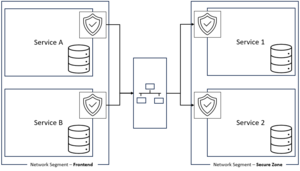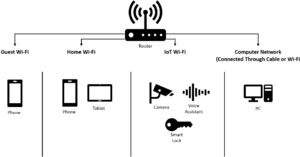Network Segmentation: Difference between revisions
From GCA ACT
Jump to navigationJump to search
No edit summary |
No edit summary |
||
| Line 15: | Line 15: | ||
[[File:network_segmentation_individuals.png|frameless|left|Home Network Segmentation]] | [[File:network_segmentation_individuals.png|frameless|left|Home Network Segmentation]] | ||
|- | |- | ||
| valign="top" | < | | valign="top" | | ||
{| role="presentation" class="wikitable mw-collapsible autocollapse" | |||
| <strong>Organizational Benefits</strong> | |||
|- | |||
| | |||
* Enhanced Security: One of the primary benefits of network segmentation is improved security. By dividing a network into smaller segments, organizations can create barriers that prevent unauthorized access between segments. This makes it significantly more challenging for cybercriminals to move laterally within a network if they manage to breach one segment. | * Enhanced Security: One of the primary benefits of network segmentation is improved security. By dividing a network into smaller segments, organizations can create barriers that prevent unauthorized access between segments. This makes it significantly more challenging for cybercriminals to move laterally within a network if they manage to breach one segment. | ||
* Reduced Attack Surface: Network segmentation reduces the attack surface, which is the total area vulnerable to cyberattacks. By isolating different parts of the network, the potential attack vectors are minimized, making it harder for attackers to compromise critical systems. | * Reduced Attack Surface: Network segmentation reduces the attack surface, which is the total area vulnerable to cyberattacks. By isolating different parts of the network, the potential attack vectors are minimized, making it harder for attackers to compromise critical systems. | ||
| Line 21: | Line 25: | ||
* Compliance and Regulation: Many industry regulations and compliance standards require organizations to implement network segmentation as a security measure. Compliance with these standards is crucial for avoiding fines and legal repercussions. | * Compliance and Regulation: Many industry regulations and compliance standards require organizations to implement network segmentation as a security measure. Compliance with these standards is crucial for avoiding fines and legal repercussions. | ||
* Resource Optimization: Network segmentation allows for better resource allocation. For example, bandwidth-intensive applications can be isolated to specific segments to ensure that they do not impact the performance of other network segments. | * Resource Optimization: Network segmentation allows for better resource allocation. For example, bandwidth-intensive applications can be isolated to specific segments to ensure that they do not impact the performance of other network segments. | ||
| valign="top" | < | |} | ||
| valign="top" | | |||
{| role="presentation" class="wikitable mw-collapsible autocollapse" | |||
| <strong>Organizational Impact</strong> | |||
|- | |||
| | |||
* Improved Incident Response: In the event of a security incident, network segmentation helps contain the breach. This containment limits the damage caused and allows security teams to respond more effectively without affecting the entire network. | * Improved Incident Response: In the event of a security incident, network segmentation helps contain the breach. This containment limits the damage caused and allows security teams to respond more effectively without affecting the entire network. | ||
* Minimized Data Exposure: If a breach occurs, the segmented structure minimizes the amount of data exposed, reducing the potential harm to an organization's reputation and financial well-being. | * Minimized Data Exposure: If a breach occurs, the segmented structure minimizes the amount of data exposed, reducing the potential harm to an organization's reputation and financial well-being. | ||
| Line 27: | Line 36: | ||
* Adaptability: Organizations can adapt network segmentation to their specific needs. Segments can be created or modified as the organization's requirements evolve, allowing for a flexible and scalable security strategy. | * Adaptability: Organizations can adapt network segmentation to their specific needs. Segments can be created or modified as the organization's requirements evolve, allowing for a flexible and scalable security strategy. | ||
* Reduced Risk: By proactively implementing network segmentation, organizations can significantly reduce the risk of a successful cyberattack. This helps protect sensitive information, maintain business continuity, and safeguard reputation. | * Reduced Risk: By proactively implementing network segmentation, organizations can significantly reduce the risk of a successful cyberattack. This helps protect sensitive information, maintain business continuity, and safeguard reputation. | ||
| valign="top" | < | |} | ||
| valign="top" | | |||
{| role="presentation" class="wikitable mw-collapsible autocollapse" | |||
| <strong>Individual Benefits</strong> | |||
|- | |||
| | |||
* Device Isolation: By segmenting your network, you can isolate different types of devices. For example, you can place your smart home devices (e.g., smart thermostats, cameras) in a separate segment from your personal computers and smartphones. This prevents a security breach on one type of device from compromising your entire network. | * Device Isolation: By segmenting your network, you can isolate different types of devices. For example, you can place your smart home devices (e.g., smart thermostats, cameras) in a separate segment from your personal computers and smartphones. This prevents a security breach on one type of device from compromising your entire network. | ||
* Guest Network: Set up a separate guest network for visitors. This network can have limited access and be isolated from your main network, preventing guests from accidentally or intentionally accessing your sensitive data. | * Guest Network: Set up a separate guest network for visitors. This network can have limited access and be isolated from your main network, preventing guests from accidentally or intentionally accessing your sensitive data. | ||
| Line 33: | Line 47: | ||
* Parental Control*: If you have children, network segmentation can help implement parental control measures. You can create a separate network segment for their devices and apply content filtering or time restrictions. | * Parental Control*: If you have children, network segmentation can help implement parental control measures. You can create a separate network segment for their devices and apply content filtering or time restrictions. | ||
* Security Testing: Network segmentation allows you to test security measures on a limited scale without risking your entire network. You can experiment with different security configurations on one segment to assess their effectiveness. | * Security Testing: Network segmentation allows you to test security measures on a limited scale without risking your entire network. You can experiment with different security configurations on one segment to assess their effectiveness. | ||
| valign="top" | < | |} | ||
| valign="top" | | |||
{| role="presentation" class="wikitable mw-collapsible autocollapse" | |||
| <strong>Individual Impact</strong> | |||
|- | |||
| | |||
* Enhanced Privacy: Network segmentation provides better control over who can access your devices and data. Your personal devices and sensitive information are less exposed to potential threats. | * Enhanced Privacy: Network segmentation provides better control over who can access your devices and data. Your personal devices and sensitive information are less exposed to potential threats. | ||
* Improved Security: If one segment is compromised, the rest of your network remains protected. This containment can prevent the spread of malware and unauthorized access. | * Improved Security: If one segment is compromised, the rest of your network remains protected. This containment can prevent the spread of malware and unauthorized access. | ||
| Line 41: | Line 60: | ||
Implementing network segmentation at home may require some technical knowledge, but it can significantly improve your cybersecurity posture. It's an effective way to protect your devices, personal information, and privacy in an interconnected world. | Implementing network segmentation at home may require some technical knowledge, but it can significantly improve your cybersecurity posture. It's an effective way to protect your devices, personal information, and privacy in an interconnected world. | ||
|} | |||
|} | |} | ||


